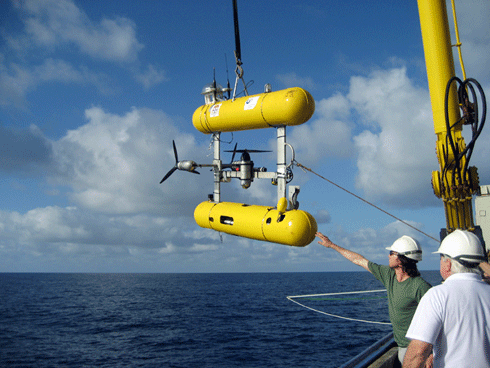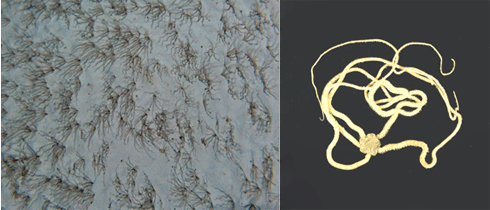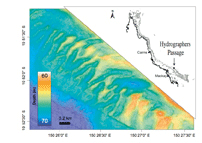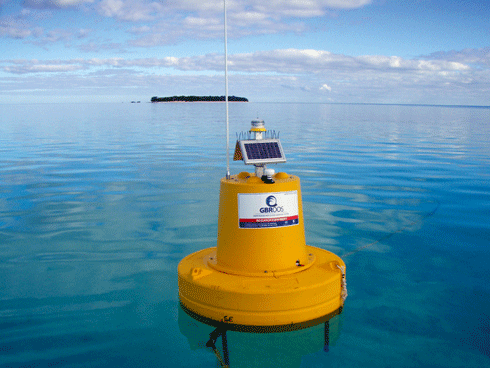
|
Published:
Flashing stars light up the Reef’s shelf
During an expedition to the shelf edge of the Great Barrier Reef, scientists captured the first images of the life associated with rolling undersea dunes and discovered a large community of aggregated brittle stars that have spectacular luminescent behaviour.

|
|
An autonomous underwater vehicle (AUV) was deployed and then operated remotely from the Southern Surveyor and surveyed the sea floor at an altitude of 2 m. Credit: University of Sydney
|
The shelf edge of the Great Barrier Reef has a complex network of drowned reef systems, paleoriver channels and dune fields. These features provide information about the evolution of the margin of the Australian continent, the nature of past climate and sea level. They are also extensive, but poorly studied habitats for more recently evolved seabed communities.
As part of the research phases of the national Integrated Marine Observing System (IMOS), scientists aboard the Marine National Facility research vessel, Southern Surveyor, made expeditions in 2007 and 2008 to the drowned shelf reefs to survey their little-known features and biodiversity. The results of their research are published in the journal EOS, Transactions American Geophysical Union.
On the 2007 voyage, an autonomous underwater vehicle (AUV) was used to survey the dunes and capture high-resolution stereo images, which were then combined with multibeam sonar (for bathymetry (depth), and backscatter (to detect water column objects)) and seismic data to provide a detailed understanding of seabed features and the animal communities that populate them.
As the AUV tracked above the bottom at a particularly dynamic area of the reef called Hydrographers Passage, ~200 km off the mainland, a vast sandy dune field supporting an extensive community of the luminescent, suspension feeding brittle stars (relatives of sea stars) came into view for the first time. Stunning images of the brittle star beds were captured by the AUV’s cameras, and a grab sample filled with these writhing stars revealed they were Ophiopsila pantherina, the flashing brittle star.

|
|
An AUV captured image of the brittle star community at Hydrographers Passage (2 m from the seabed). Right: the flashing brittle star with its extensive feeding arms. Credit: University of Sydney
|
These brittle star beds are likely to be an ecologically important community and the discovery adds yet another unique animal community to the Great Barrier Reef Marine Park. The dunes support the vast aggregations of O. pantherina, a relatively large animal, but little other obvious life.
The rolling dunes are 1–5 m in height and at Hydrographers Passage cover ~340 ha of sea floor in 60 to 70 m of water. They project into a dynamic environment characterised by strong tidal currents. Each tidal cycle brings nutrient-rich water from the continental slope up onto the shelf, establishing the current and nutrient conditions ideal for suspension feeders.
Set on the lee side of the dunes, the brittle stars take advantage of their elevated position for feeding. With their body disc in a sand burrow, they extend their arms to feed in the direction of the current flow. At an incredible density of over 418 individuals per square metre, the stars form an impressive ‘wall of arms’ capturing plankton from this flowing shelf water.
The aggregations of O. pantherina are a living example of the suspension feeding communities that once flourished, 500 million years ago, in the Palaeozoic era. These ancient communities eventually declined because of the diversification of predators, and it is due to this predation pressure – mainly from fishes – that modern brittle stars tend to be cryptic, generally emerging at night to feed.

|
|
A multibeam reconstruction of the dune field at Hydrographers Passage. Credit: University of Sydney
|
However, unlike nocturnal feeding by brittle stars in shallower water, a behaviour that avoids daytime visual predators that graze the arms, O. pantherina was seen feeding during the day. At a depth of 70 m on the dunes, light is significantly reduced and this probably gives the stars extended time for feeding with reduced predation pressure.
The brittle stars do, however, still exhibit the defensive self-mutilation characteristic of other brittle stars, casting off their arms when harassed. But they appear to use this defence less regularly than other species.
This might be because they have other arresting defensive mechanisms – rapid arm retreat and a spectacular flash on contact. O. pantherina is intensely bioluminescent. On contact, the brittle star’s arms emit visible light in a bright green flash that travels down the arm. The flash’s intensity depends on strength stimulation. This bioluminescence has evolved as a defensive function, visually stunning predators that bump into or attack the arm (a short video of this behaviour is on our website).
These first in situ images of the biological and physical features of the dune ecosystem highlight the important insights that can be gained from multidisciplinary investigations of offshore waters normally out of reach to study by conventional SCUBA techniques. In this case the AUV imagery revealed a hitherto unknown community of large suspension feeders likely to have a major ecological role in regulating planktonic production.
The recent rezoning of the Great Barrier Reef Marine Park was based on protection of the broad range of habitats and communities in the region.
These recently discovered brittle star fields in the dune areas now represent a new benthic community for consideration in the management of inter-reef habitats in the Marine Park.
|
The Australian Integrated Marine Observing System (IMOS) is a national research infrastructure program led by the University of Tasmania, and involving Commonwealth, state, university and industry partners. It began in 2007 and has just been given a major boost in this year’s federal budget, as part of the Marine and Climate Super Science Initiative. IMOS received a further $52 million to extend and enhance the program out to 2013, and to fill critical gaps in Southern Ocean and northern Australian water research. |

One of the sensor floats that makes up the IMOS sensor network at Heron Island, infrastructure which forms part of the Facility for Automated Intelligent Monitoring of Marine Systems (FAIMMS). Credit: AIMS
|
On 29 June, IMOS launched its ‘Ocean Portal’ – an innovative system that makes ocean data freely available via the internet. Data from all IMOS facilities around Australia can now be searched, viewed and retrieved in near ‘real time’. See http://imos.aodn.org.au. |
Recent highlights from the IMOS facilities: |
The Argo facility has already exceeded the milestone for June 2009 with 221 active Argo robotic ocean floats reporting useable data. |
The Australian National Facility for Ocean Gliders has successfully completed repeat deployments off New South Wales, Tasmania, South Australia and Western Australia. The data obtained from these glider missions are providing a unique view of the oceanic variability around Australia. |
The National Reference Station Mooring off Maria Island has been delivering real time data since April, using a newly designed and developed telemetry surface buoy deployed within close proximity to the existing in situ sensors. |
The Australian Continuous Plankton Recorder survey (AusCPR) has successfully deployed a plankton recorder behind the commercial vessel ANL Windarra from Brisbane to Melbourne on 27–29 June, collecting the first monthly samples for phytoplankton and zooplankton species identification along the East Australia Current. |
The Facility for Automated Intelligent Monitoring of Marine Systems has successfully deployed the world’s first large-scale coral reef sensor network which has been measuring a range of parameters for the last eight months. |
The Australian Acoustic Tagging and Monitoring System and Fisheries Western Australia recently deployed the first International Ocean Tracking Network (OTN) array in the world. This line runs from Fremantle to Rottnest Island and extends seaward from here to the 200-m mark. |
Contact:
Maria Byrne, Stefan Williams, Erika Woolsey and Jody Webster, University of Sydney, mbyrne@anatomy.usyd.edu.au
More information:
Webster JW et al. (2008) From corals to canyons: the Great Barrier Reef margin. EOS, Transactions American Geophysical Union 89, 217–218.
Integrated Marine Observing System, http://imos.org.au
The voyages SS07/2007, SS09/2008 were funded by the Marine National Facility, Integrated Marine Ocean Observing System and National Geographic.1
1 Project researchers were Maria Byrne, Stefan Williams, Erika Woolsey, Peter Davies, Kate Thornborough, Tom Bridge, Robin Beaman, Jody Webster, and Oscar Pizarro.



